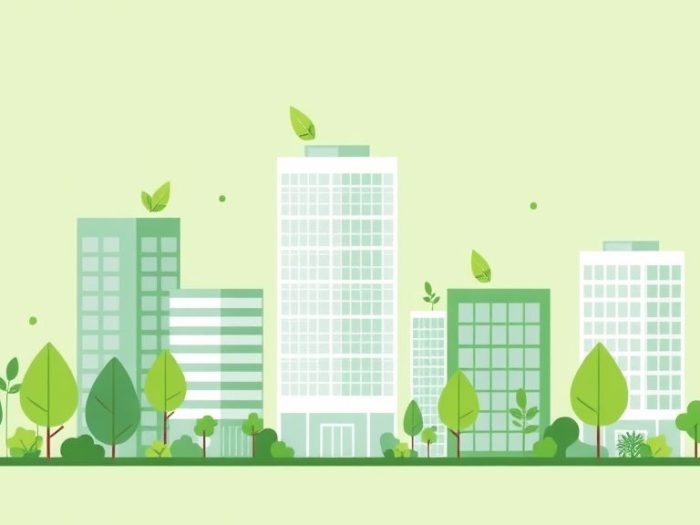The real estate sector is increasingly focusing on sustainability, and Green Building
Real Estate Investment Trusts (REITs) are at the forefront of this trend. These REITs
invest in properties designed and operated to minimize environmental impact and promote
social responsibility. This article explores the potential for strong returns in Green
Building REITs and the factors driving their growth.
Understanding Green Building REITs
REITs are companies that own, operate, or finance income-producing real estate. Green
Building REITs focus specifically on properties that meet certain environmental and
sustainability standards. These standards often include certifications like:
-
LEED (Leadership in Energy and Environmental Design): A globally
recognized rating system for green building design, construction, operation, and
maintenance. -
ENERGY STAR: A U.S. Environmental Protection Agency (EPA) program
promoting energy efficiency. -
BREEAM (Building Research Establishment Environmental Assessment Method):
A sustainability assessment method for buildings.
Benefits of Green Building REITs
Investing in Green Building REITs offers several potential advantages:
-
Reduced Operating Costs: Green buildings often have lower energy and
water consumption, leading to cost savings for tenants and owners. -
Increased Occupancy Rates: Tenants are increasingly attracted to
sustainable and healthy buildings. -
Higher Rental Income: Green buildings may command higher rents due to
tenant demand. -
Lower Risk: Green buildings may be more resilient to climate change
and regulatory changes. -
Positive Impact: Investing in green buildings contributes to a more
sustainable environment and society.
Sectors within Green Building REITs
Green Building REITs invest in various property types:
- Office buildings
- Apartments
- Industrial properties
- Retail spaces
- Healthcare facilities
Factors Driving Growth
Several factors are driving the growth of Green Building REITs:
- Tenant Demand: Businesses and individuals are increasingly seeking sustainable spaces.
- Government Regulations: Building codes and regulations are becoming stricter on energy efficiency and sustainability.
- Investor Interest: ESG (Environmental, Social, and Governance) investing is growing, increasing demand for green investments.
- Cost Savings: The long-term cost benefits of green buildings are becoming more apparent.
Finding Green Building REITs
You can find Green Building REITs through:
- REIT Indexes: Some REIT indexes specifically focus on green building properties.
- Brokerage Platforms: Many brokerage platforms allow you to screen REITs based on ESG criteria.
- Financial News Sources: Websites and publications that cover real estate and ESG investing.
Evaluating Green Building REITs
When evaluating Green Building REITs, consider:
- Property Portfolio: The types and locations of the properties owned by the REIT.
- Certification Levels: The percentage of properties with LEED, ENERGY STAR, or other certifications.
- Financial Performance: Traditional REIT metrics like FFO (Funds From Operations) and dividend yield.
- Management Quality: The experience and track record of the REIT’s management.
Risks of Investing in Green Building REITs
- Market Risk: Like all REITs, Green Building REITs are subject to real estate market fluctuations.
- Interest Rate Risk: REITs can be sensitive to changes in interest rates.
- Property-Specific Risks: Vacancy rates, maintenance costs, and other property-related issues.
- Greenwashing: The risk that a REIT’s claims about sustainability are exaggerated.
Conclusion
Green Building REITs offer an attractive investment opportunity for those seeking both
financial returns and positive environmental impact. The demand for sustainable real
estate is growing, and these REITs are well-positioned to benefit from this trend.
However, it’s essential to conduct thorough research and consider the inherent risks
before investing.
Related Keywords
Green building REITs, sustainable real estate, LEED certified REITs, ESG REITs, real
estate investing, REITs, green building, sustainable investing, ethical real estate,
eco-friendly REITs.
Frequently Asked Questions (FAQ)
1. What are Green Building REITs?
Green Building REITs are Real Estate Investment Trusts that invest in properties
designed and operated to minimize environmental impact and promote sustainability.
2. What are some common green building certifications?
Common certifications include LEED, ENERGY STAR, and BREEAM.
3. What is LEED certification?
LEED (Leadership in Energy and Environmental Design) is a globally recognized
rating system for green building design, construction, operation, and maintenance.
4. What are the benefits of investing in Green Building REITs?
Benefits include reduced operating costs, increased occupancy rates, higher
rental income, lower risk, and positive environmental impact.
5. What types of properties do Green Building REITs invest in?
Green Building REITs invest in various property types, including office
buildings, apartments, industrial properties, and retail spaces.
6. What factors are driving the growth of Green Building REITs?
Growth is driven by tenant demand, government regulations, investor interest in
ESG, and cost savings from energy efficiency.
7. How can I find Green Building REITs to invest in?
You can find them through REIT indexes, brokerage platforms with ESG screens,
and financial news sources.
8. What should I consider when evaluating Green Building REITs?
Consider the property portfolio, certification levels, financial performance
(like FFO and dividend yield), and management quality.
9. What are the risks of investing in Green Building REITs?
Risks include market risk, interest rate risk, property-specific risks, and the
potential for greenwashing.
10. Are Green Building REITs a good long-term investment?
Green Building REITs can be a good long-term investment due to the growing
demand for sustainable real estate, but careful research and risk management
are essential.



